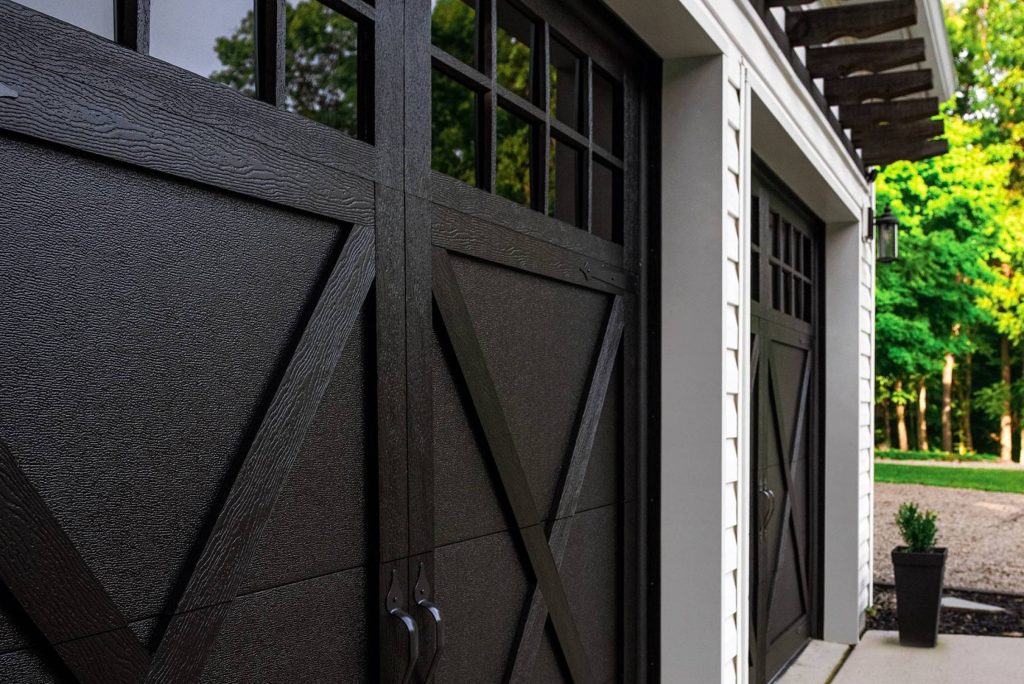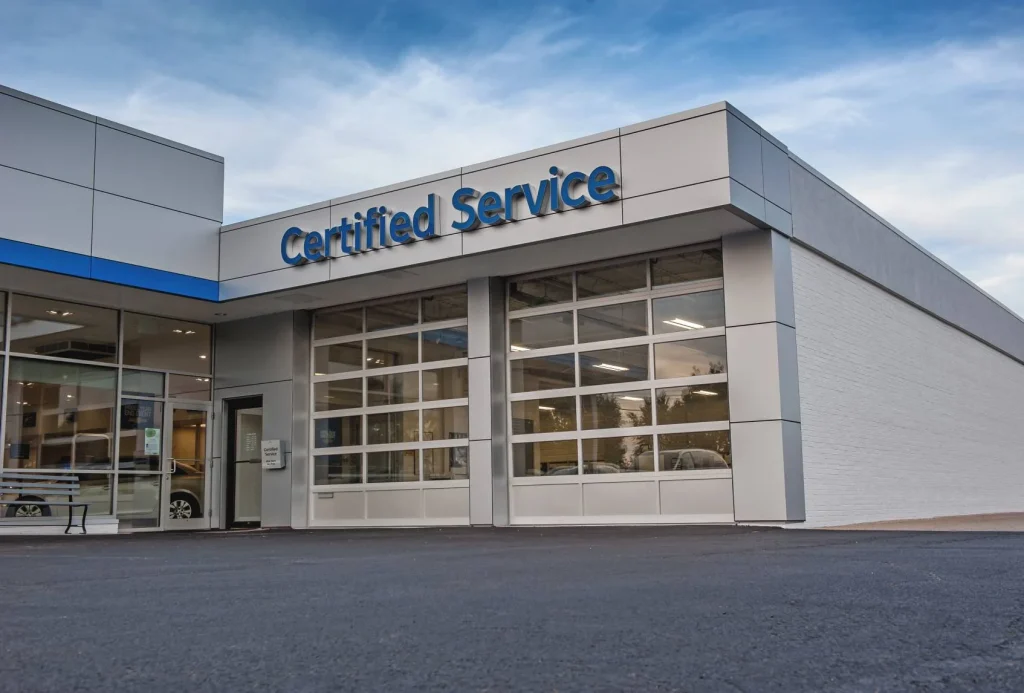Garage Door Fixes in Hazel Park, MI
Quick and Affordable Fixes for Smooth Operation
Locally Based, Regionally Trusted
Since 2017
Schedule A Service Request
We Serve Businesses In And Around The Following Cities:
About Garage Door Fixes
Comprehensive Guide to Garage Door Fixes in Hazel Park for Commercial Properties
As urban landscapes evolve, the vital role of physical infrastructure often remains quietly in the backdrop — a necessity without which the dynamics of business operations would suffer. In Hazel Park, a city demonstrating a charming blend of historical allure and modern hustle, commercial properties rely significantly on elements that ensure smooth operations — one of the critical components being garage doors. Commercial garage doors, unlike their residential counterparts, are subject to higher frequency usage, more significant wear and tear, and often serve a variety of functions, from basic storage to housing essential vehicles and equipment. Hence, understanding the intricacies of garage door fixes becomes crucial for businesses aiming for operational efficiency and security.
Recognizing the Importance of Garage Door Maintenance
In the business-centric veins of Hazel Park, commercial entities demand not only reliability but resilience from their infrastructure. Garage doors are gateways to businesses, often representing the first point of utility and security. Regular maintenance and timely garage door fixing can prevent unforeseen disruptions that could incur substantial financial losses. For instance, imagine a local delivery service housed in the heart of Hazel Park; a malfunctioning garage door could mean delayed shipments, impacting customer satisfaction and revenue. Maintaining these doors ensures seamless operations, fortifying the backbone of any commercial setup.
The necessity of garage door fixes transcends beyond the mundane need for functionality; it assures security, energy efficiency, and safety. Particularly in a locale like Hazel Park, known for its vibrant commercial pulse, businesses can ill-afford jeopardized access or unsafe conditions stemming from neglected doors. Timely intervention and expert fixes help mitigate risks such as unauthorized access or operational downtime. Therefore, comprehensively approaching garage door upkeep is not merely a mitigation tactic; it's a proactive strategy for unfaltering business operations.
The Process of Garage Door Fixing
Embarking on the journey of garage door fixing for your commercial property in Hazel Park involves a nuanced understanding of several components. The process typically starts with an assessment phase where professionals evaluate the condition and functionality of the door. This analysis helps determine whether the issue stems from hardware malfunctions, software glitches, or wear-induced fatigue parts. Such a precise diagnosis is where the local expertise of a garage door fixer near you becomes invaluable.
Once the root cause is identified, the next phase involves executing the fix. This can range from simple tasks like aligning tracks, tightening brackets, and lubricating moving parts to more complex interventions like replacing springs, cables, or even the entire door panel for severe cases. Advanced technological systems that contemporary commercial garage doors incorporate demand competent handling to ensure seamless integration with existing structures.
In Hazel Park, reputable service providers such as D&J Contracting bring a wealth of experience and a keen understanding of local architectural nuances, ensuring that the fixes are both effective and aesthetically harmonious with the business's infrastructure. Opting for expert assistance not only guarantees adept handling of the issue but also extends the door's lifespan, ultimately saving costs in the long run.
Real-World Benefits for Hazel Park Businesses
The merits of investing in regular garage door fixes are manifold, each contributing distinct advantages that collectively amplify business efficiency and security. One profound benefit is the assurance of safety and security. Well-maintained garage doors serve as formidable barriers against unauthorized entries, a critical consideration for Hazel Park enterprises storing high-value equipment or sensitive data.
Moreover, consistent maintenance diminishes the probability of mechanical failures that could interrupt daily operations. For instance, a local manufacturing firm aligning its logistics schedule with precision can ill afford such interruptions. Hence, routine checks and prompt garage door fixes foster an environment of reliability. Businesses thrive on predictability and renowned service providers like D&J Contracting can imbue this essential predictability through proficient maintenance services.
Furthermore, the cost of fixing a garage door pales in comparison to the cumulative losses unaddressed issues could incur. By proactively managing the health of your garage doors, businesses in Hazel Park can prevent potential revenue dip, productivity loss, and even reputational damage arising from operational halts or compromised security.
Preserving Energy Efficiency in Commercial Properties
Environmental consciousness is not merely a nod to current trends but a business imperative. The unheralded hero in energy efficiency for commercial properties often manifests as a well-insulated and maintained garage door. When a garage door installment is meticulously chosen and diligently maintained, it significantly contributes to energy conservation within an enterprise.
In a city like Hazel Park, where diverse weather patterns can affect internal building temperatures, garage doors act as critical buffers. Malfunctioning or poorly maintained doors can lead to energy leaks, thereby increasing utility costs and leaving a heavier carbon footprint. Addressing garage door fixes timely can prevent these inefficiencies. Service providers who understand the local climate nuances can offer tailored solutions for insulation and maintenance, helping businesses maintain optimal energy usage.
The Role of Technology and Modern Solutions
Today's commercial garage doors are increasingly sophisticated, often integrating smart technologies that enhance utility and security. From automation and remote operations to advanced security features, the evolution of garage doors demands an equally advanced approach to maintenance and fixes. Modern garage doors in Hazel Park commercial properties might include components that interface with network systems, adding layers to both their capabilities and the complexity of their maintenance.
For local businesses investing in such advanced systems, understanding the maintenance protocols associated with these technologies is crucial. Providers like D&J Contracting excel in this space, offering insights and services that ensure technology-driven enhancements smoothly dovetail into existing operations. This can include installing sensors that provide real-time data on door condition, ease of use integration with control systems, and implementing security protocols that protect against unauthorized access — an assurance highly prized by commercial entities.
Customized Solutions for Hazel Park Enterprises
Each commercial property in Hazel Park harbors its unique structural and operational requirements. Hence, a one-size-fits-all approach to garage door fixes often falls short of meeting specific business needs. Customized solutions that consider factors such as the intensity of door usage, the environmental disposition, and architectural congruence are fundamental. A garage door fixer near you who appreciates these distinctions can tailor maintenance schedules, choose appropriate materials, and suggest enhancements that ensuring the doors serve their full potential.
Businesses benefit immensely from such personalized attention, as it assures that their operational frameworks mesh seamlessly with the robust physical components vital to their operations. In local setups where efficiency often aligns with competitive advantage, these tailored fixes foster an ecosystem where the enterprise can perform unpredictably and competitively.
To epitomize this, consider a bustling Hazel Park property management firm utilizing multiple bays for vehicular access. The frequency and volume of usage necessitate enduring, adaptable roofing solutions. Here, bespoke services from a reputed contractor such as D&J Contracting offer a compelling choice, combining expertise with hands-on local knowledge, perfect for addressing the complex landscape of modern commercial garage doors.
Crafting a holistic understanding of the needs and solutions surrounding commercial garage door fixes in Hazel Park forms a powerful foundation for business longevity. Through proactive strategies, commitment to maintenance, and embracing technological advancements, businesses elevate not only their operational standing but also fortify their market positioning. It is such comprehensive care and attentiveness that underscore the importance of amenities often overlooked, transforming them into pillars of enterprise success.
Garage Door Fixes Gallery



Call Us Today to receive your Free Quote for Garage Door Fixes in Hazel Park
Serving: Hazel Park, Michigan

About Hazel Park, Michigan
This area was long occupied by indigenous peoples, with such historic and current tribes as the Potawatomi and others known to European fur traders and colonists from the 17th century.
In the later 19th century, as westward migration increased from the eastern United States to the Great Lakes territories, this area was settled by European Americans. They first developed it for agriculture. In October 1882, a group of farmers gathered to organize the community's first school. They built a one-room school in 1883 and later expanded it to two rooms. In 1884, John W. Benjamine petitioned the state of Michigan to form a school district from Royal Oak Township. Benjamine, who was School Inspector for Royal Oak Township, named it Hazel Park School District 8, after the abundant hazelnut bushes in the area.
In 1920, the Thomas W. Lacey School, was built on present-day Woodruff Avenue. The first Hazel Park school had been sold to Frank Neusius, who used it as a barber shop and neighborhood grocery.
Given a rapid increase in this period of the number of school-age children as population grew, the school district soon added four grade schools. It built a larger building at the central location, also called the Lacey School. This became the site for high school students. With further postwar population growth, Hazel Park High School was built. The former high school at John R and 9 Mile Roads was used as Lacey Junior High School.
Hazel Park's growth was stimulated by the expansion of jobs at the Ford Motor Company, based in nearby Highland Park. Hospitals, offices and shops were developed in the area of 9 Mile Road. The electric Stephenson Line was a convenient way for commuters to travel by trolley to Highland Park and Detroit. In 1924, Hazel Park installed its first traffic light, was granted a post office, and established a Deputy Sheriff's office. The city was incorporated in 1941.
During the 1930s and 1940s, rallies and community events helped the city during the Great Depression and the years of World War II. Large parts of the auto industry were converted to production of defense-related goods, and thousands of people migrated into the area for new jobs. After the city's incorporation, it improved the infrastructure and provided running water to all areas.
In 1942, the Elias Brothers, John, Fred and Louis Elias, established a diner in Hazel Park. The Dixie Drive-In was one of the first in the Midwest to offer curbside services. In 1952, the diner was franchised as a Big Boy restaurant. Louis Elias was elected as Mayor of Hazel Park, serving two terms from 1953 to 1961. The Elias brothers continued to open Big Boy restaurants throughout the Metro Detroit area and in 1983 purchased the franchiser.
With the return of thousands of soldiers from World War II, housing demand was very high in the area. It stimulated a boom in construction. Many of the current bungalows in the city were built shortly after the war.
Hazel Park Raceway opened for thoroughbred horse racing in 1949. It was considered a state-of-the-art facility. Harness racing was added in 1953. In 1950 the Detroit Race Course opened in Livonia, Michigan, to the north of Detroit, offering competition with both flat and harness racing. In 1996 the state legislature approved onsite betting at racetracks for simulcast events, and the track was opened year round for patrons to view on racing events from across North America. In 2018 the profitable Hazel Park track was closed after being sold. The new owner wanted to use the large property to develop new warehouse space for an Amazon distribution center.
In 1966 the Interstate 75 (I-75) freeway was fully completed through Hazel Park, as part of the postwar highway construction subsidized by the federal government. It superseded Stephenson Highway, now used as a service drive. Similarly, I-696 was constructed through the neighboring city of Madison Heights in 1979; it joins the two freeways and creating a busy junction with I-75, part of which extends into Hazel Park's north end.
According to the United States Census Bureau, the city has a total area of 2.82 square miles (7.30 km), all land.
Hazel Park is adjacent to the cities of Detroit to the south, Ferndale to the west, Royal Oak to the northwest, Madison Heights to the north, and Warren to the east. The city is bordered by 10 Mile Road to the north, I-696 at its northwest corner, Dequindre Road (the Oakland-Macomb county line) to the east, 8 Mile Road (M-102) to the south, and West End Street, Pilgrim Avenue, and Lenox Street to the west.
| Census | Pop. | Note | %± |
|---|---|---|---|
| 1950 | 17,770 | — | |
| 1960 | 25,631 | 44.2% | |
| 1970 | 23,784 | −7.2% | |
| 1980 | 20,914 | −12.1% | |
| 1990 | 20,051 | −4.1% | |
| 2000 | 18,963 | −5.4% | |
| 2010 | 16,422 | −13.4% | |
| 2020 | 14,983 | −8.8% | |
| source: | |||
| Year | $ | ±% |
|---|---|---|
| 1990 | 35,667 | — |
| 1997 | 39,118 | +9.7% |
| 2000 | 37,045 | −5.3% |
| 2005 | 38,300 | +3.4% |
| 2007 | 39,783 | +3.9% |
| 2009 | 40,403 | +1.6% |
The median income for a household in the city in 2008 was $40,403, and the median income for a family was $49,448. The per capita income for the city was $19,390. About 10.0% of families and 12.4% of the population were below the poverty line, including 17.0% of those under age 18 and 7.6% of those age 65 or older.
As of the census of 2010, there were 16,422 people, 6,641 households, and 3,999 families residing in the city. The population density was 5,823.4 inhabitants per square mile (2,248.4/km). There were 7,611 housing units at an average density of 2,698.9 per square mile (1,042.1/km). The racial makeup of the city was 85.8% White, 6.8% African American, 0.9% Native American, 0.5% Asian, 0.4% from other races, and 4.6% from two or more races. Hispanic or Latino residents of any race were 2.7% of the population.
There were 6,641 households, of which 31.8% had children under the age of 18 living with them, 33.7% were married couples living together, 18.9% had a female householder with no husband present, 7.6% had a male householder with no wife present, and 39.8% were non-families. 32.2% of all households were made up of individuals, and 11.3% had someone living alone who was 65 years of age or older. The average household size was 2.47 and the average family size was 3.13.
The median age in the city was 36.1 years. 24.2% of residents were under the age of 18; 9.3% were between the ages of 18 and 24; 29.5% were from 25 to 44; 25.6% were from 45 to 64; and 11.3% were 65 years of age or older. The gender makeup of the city was 49.4% male and 50.6% female.
In 2000, there were 7,284 households, out of which 33.4% had children under the age of 18 living with them, 41.6% were married couples living together, 16.1% had a female householder with no husband present, and 35.9% were non-families. 28.4% of all households were made up of individuals, and 11.1% had someone living alone who was 65 years of age or older. The average household size was 2.60 and the average family size was 3.21.
In the city, 27.7% of the population was under the age of 18, 9.5% was from 18 to 24, 33.2% from 25 to 44, 18.1% from 45 to 64, and 11.5% was 65 years of age or older. The median age was 33 years. For every 100 females, there were 97.3 males. For every 100 females age 18 and over, there were 94.0 males.
73.1% of all households in Hazel Park were family households. 20.9% of all households were married couple families with children. 10.6% were single-mother families.
The census reported the city as 81.1% White, 9.7% African American, 0.90% Native American, 1.5% Asian, 0.90% from other races, and 4.20% from two or more races. Hispanic or Latino residents of any race were 2.7% of the population.
The top reported ancestries in the city were German (18.6%), Irish (14.8%), Polish (10.3%), English (9.7%), French (6.0%) and Italian (4.1%) Italian. French Canadians (3.6%), Scottish (3%), Arab (2.5%) and Dutch (1.6%). The city has the second-largest proportion of Native American residents in Oakland County, after Keego Harbor.
In 2000, 7.2% of Hazel Park citizens were foreign born. 9.7% reported speaking a language other than English.
As of the 2000 Census, the median income for a household in the city was $37,045, and the median income for a family was $43,584. Males had a median income of $33,063 versus $24,362 for females. The per capita income for the city was $16,723.
Hazel Park has a Council-Manager form of government. It is governed by an elected City Council consisting of a mayor and four council members. The city council appoints a City Manager, who manages the day-to-day operations of the city. The current mayor of Hazel Park is Michael Webb, who succeeded Jeffrey Keeton. Jan Parisi, the city's first woman mayor, resigned in 2016 due to health-and family-related reasons.
Current city council members are Alissa Sullivan, who also serves as Mayor Pro Tem, Andy LeCureaux, Luke Londo, and Mike McFall. The current city manager is Edward Klobucher. City government is located on the same block as the public library, police station, and post office, at 9 Mile Road and John R Road.
The Hazel Park Police Department has a force of 42 full-time police officers. The department has auxiliary policing and neighborhood watch programs available to citizens ages 21 and over. The police department offers programs such as gun lock giveaways, house watch programs, and programs to put a child up for adoption in case the parent is not capable of raising the child.
| District | Representative | Party | Since |
|---|---|---|---|
| 11th | Haley Stevens | Democratic | 2023 |
| District | Senator | Party | Since |
|---|---|---|---|
| 3rd | Stephanie Chang | Democratic | 2023 |
| District | Representative | Party | Since |
|---|---|---|---|
| 8th | Mike McFall | Democratic | 2023 |
| District | Commissioner | Party | Since |
|---|---|---|---|
| 3 | Ann Erickson Gault | Democratic | 2023 |
The city is served by the Hazel Park School District, which has some establishments in Ferndale, a neighboring city. There are three elementary schools operating in the city of Hazel Park.
The northern portion of the city is served by Webb Elementary, while the southern portion is served by United Oaks Elementary and Hoover Elementary. Multiple other elementary schools once operated in the city, including Roosevelt, Lee O. Clark, Longfellow, Henry Ford, Webster, and Edison Elementaries. Webster was closed as an elementary school at the end of the 2014 school year, but remains open for the Preschool program. Lee O. Clark has since been demolished, and Henry Ford has been converted into the School District Administration Building. Henry Ford also serves as an alternative education facility for students K-8 called Advantage, and a program called Breakfast Club for high school students. There is one high school and one middle school operating in Hazel Park. Hazel Park has followed a recent trend in Metro Detroit suburbs by the consolidation of its middle schools. Formerly, two separate schools, Webb Junior High and Beecher Middle School, operated in the city. Webb was converted to an elementary school in 2004, and Beecher was torn down and re-built, commissioned as Hazel Park Junior High.
High schools in Hazel Park began with the construction of Lacey High School in 1920 and Hazel Park High School in 1929. Lacey High was demolished in the early 1960s, and the Hazel Park High School was re-commissioned as Howard Beecher Junior High. In 1961, a new high school was built in the eastern portion of the city, taking the name of Hazel Park High School.
Jardon Vocational School is also in operation in order to separate special needs students from the mainstream curriculum and serves as a high school. The school operates mainly in the Hazel Park-Ferndale-Pleasant Ridge area, but also serves the rest of Oakland County, especially the south east.
The high school had an average score of 10.3 on the state's MEAP test in 2011. This was one of the lowest scores in Oakland County.
